4 min read
The Ultimate Guide to Investment Reporting
As regulations and market conditions change, producing thorough, precise, and timely investment reports becomes increasingly important.

How important is it to build client trust?
What about being transparent?
The only answer here is a resounding, “Very!” And quality investment reporting is an essential factor to achieving both.
What Is Investment Reporting? Why Is It Important?
Investment reporting is the process of creating and distributing detailed analyses of investment portfolios. These reports cover performance, asset composition, and investment strategies, and provide key information to stakeholders, including clients, regulators, and internal decision-makers at investment firms.
Investment reporting is important for several reasons:
- Transparency and trust: Reports offer a clear view of performance and strategy, fostering long-term client relationships.
- Decision-making and risk management: Reports inform strategic decisions and highlight potential risks and areas for improvement.
- Compliance: Investment reports play a crucial role in meeting regulatory requirements and industry standards.
- Performance evaluation: Reports provide a basis for benchmarking and evaluating the effectiveness of strategies and manager skills.
- Education: Well-crafted reports help stakeholders better understand investment concepts and market dynamics.
Typically, an investment report should include elements like investment style, objectives, performance metrics, risk-return ratio, asset allocation, distributions, fees, and tax status. Importantly, the report should clarify any style, strategy, and assumptions alterations while providing a rationale for any changes to past performance data.
Templates can address the needs of different stakeholers. These templates, populated directly from data sources, allow for a uniform, on-brand, and compliance-friendly message that can be delivered effectively. Superior investment reports:
-
Detail fee disclosures
-
Consider the client’s needs and preferences
-
Present risks and outcomes in a straightforward and transparent way
Ultimately, investors are best served with performance information that is concise, timely, and relevant. Careful consideration should be given to visually representing data using charts, style boxes, and ratings. Visuals should serve a specific purpose and not be included simply because they can be.
Workflow Challenges
While essential, the investment reporting process is full of challenges that asset and wealth managers must overcome to create timely, accurate, and actionable reports. But to solve a challenge, you need to understand the challenge.
Data management is a primary hurdle. Statista research indicates that 90% of the world’s current data was created in the last two years alone, while 402.74 million terabytes of data created each day. That's a lot of data to process, which is overwhelming and cumbersome for teams already working at max capacity.
This data often comes in various formats and from multiple sources, making integration challenging. Ensuring data integrity is crucial. Even small errors can lead to significant misrepresentations, which can negatively impact your investment reports, your brand, and your clients.
Regulatory compliance adds another layer of complexity. Regulatory reporting requirements change frequently, requiring constant vigilance and system updates and global firms must navigate requirements across different countries and regions.
Other significant challenges include:
- Customization vs. timeliness: Balancing diverse client needs with the demand for rapid reporting.
- Technology Integration: Seamlessly incorporating data from various systems and overcoming issues with legacy technology.
- Visualization and Presentation: Presenting complex data in an easily digestible format while meeting expectations for interactive, digital reports.
- Cost Management: Balancing the need for advanced reporting capabilities with budget constraints.
- Security and Confidentiality: Protecting sensitive financial information throughout the reporting process. Failure to do so could lead to hefty penalties and reputational damage.
Addressing these challenges requires a multi-faceted approach which combines advanced technology, skilled personnel, and well-designed processes. Asset and wealth managers who can effectively navigate these challenges stand to gain a significant competitive advantage in the marketplace.
Types of Investment Reports
Investment reports can broadly be categorized into internal and external reports, each serving distinct purposes and audiences. However, as client expectations evolve and regulatory demands increase, some reports may serve dual roles, offering both external transparency and internal strategic insights. This flexibility allows investment firms to meet diverse needs efficiently, enhancing both client relationships and operational effectiveness.
External Investment Reporting
External reports are designed for clients, investors, regulatory bodies, and other external stakeholders. They typically focus on performance, risk, and compliance. Common types include:
Performance Reporting
Investment performance reports provide a comprehensive overview of how an investment or portfolio has performed over a specific period. They're crucial for helping clients understand the value their investments are generating and how they compare to relevant benchmarks.
These reports typically include total returns over various time periods, benchmark comparisons, and attribution analysis, breaking down performance to understand which decisions or market factors contributed to or detracted from returns. Visual representations of historical performance trends and risk-adjusted return metrics are also common features.
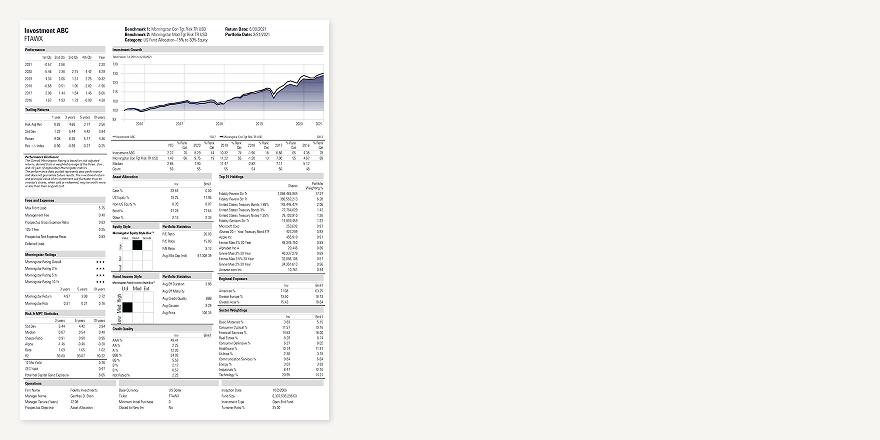
Morningstar Performance Report
Risk Reporting
For wealth managers, understanding your clients’ risk tolerance level is essential for delivering the best service possible and maintaining high retention rates. Gaining deep insights into portfolio risk factors and market dynamics is critical for asset managers to optimize strategy performance and manage downside.
Risk Reports offer insights into the potential downsides and volatility associated with investments. They’re essential for helping clients understand the level of risk they are exposed to and how it aligns with their risk tolerance and investment objectives.
Key components include Value at Risk (VaR) analysis, stress test results showing how the portfolio might perform under various adverse market scenarios, and liquidity risk assessments. Good risk reporting also includes concentration risk, currency risk, and interest rate sensitivity, depending on the nature of the investments.
ESG Reporting
ESG reports help clients understand how their investments align with their values and how ESG factors might impact long-term performance.
Components include environmental impact metrics (like carbon footprint), social responsibility indicators, and governance structure and policies.
Regulatory Reporting
Regulatory reports are designed to meet specific regulatory requirements. The nature of these reports can vary depending on the jurisdiction and type of investment vehicle.
Common types include AIFMD reports for alternative investment fund managers in the European Union, Form PF for private fund advisers in the United States, and MiFID II transaction reports for firms operating in the European Union. These reports typically focus on risk exposures, leverage levels, liquidity profiles, and compliance with investment restrictions.
Factsheets
Factsheets provide a concise summary of key information about a fund or investment product. They’re designed to give potential investors a quick but comprehensive overview of an investment opportunity.
Typical components include investment objectives and strategy, key performance data, risk metrics, top holdings, asset allocation breakdown, and fund manager information. Factsheets are designed to be visually appealing and easy to read, often fitting on a single page or two.
Internal Investment Reporting and Strategy Analysis
Asset Allocation
Asset allocation reports break down the composition of a portfolio across different asset classes, helping managers ensure alignment with investment strategies and risk tolerance.
These reports include current asset allocation versus target allocation, drift analysis, and rebalancing recommendations. More sophisticated versions might include risk contribution by asset class and liquidity analysis. Style box analysis and style drift monitoring are often incorporated to maintain consistency with stated investment objectives.
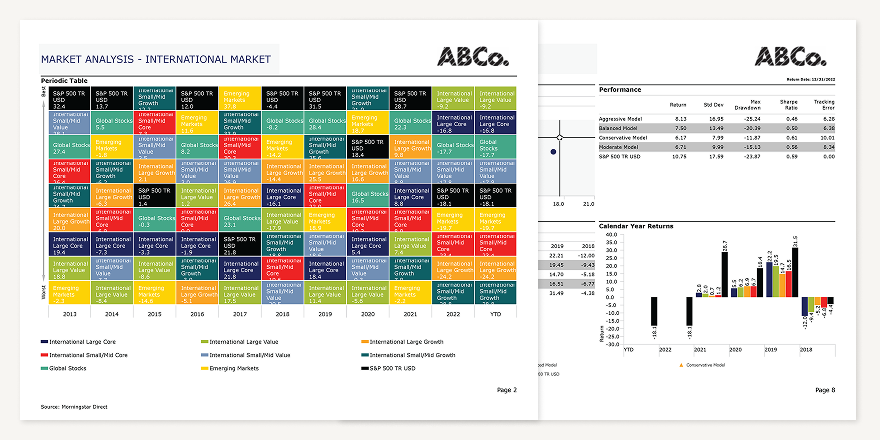
Morningstar Allocation Report
Investment Strategy Reporting
Investment strategy reports provide an in-depth analysis of portfolio performance and risk characteristics. They’re essential for informing decision-making and refining investment strategies.
Key components often include scenario analysis, Monte Carlo simulations, and efficient frontier analysis. These advanced techniques help managers anticipate potential outcomes, assess long-term risks, and identify optimal asset allocations for given risk levels.
Attribution Analysis
Attribution analysis reports break down portfolio performance to identify the sources of returns. They help managers understand which aspects of their strategy drive performance.
These reports typically separate the effects of asset allocation decisions from security selection. Key components include sector allocation effect, security selection effect, currency effect (for international portfolios), and interaction effect.
Peer Comparison and Competitive Analysis
Peer comparison and competitive analysis reports benchmark a fund or portfolio’s performance against similar offerings in the market. They help managers understand their competitive position and identify areas for improvement.
Typical elements include performance comparisons across various time periods, risk-adjusted return metrics, fee comparisons, and style consistency analysis. These reports are crucial for maintaining a competitive edge and can inform product development and marketing strategies.
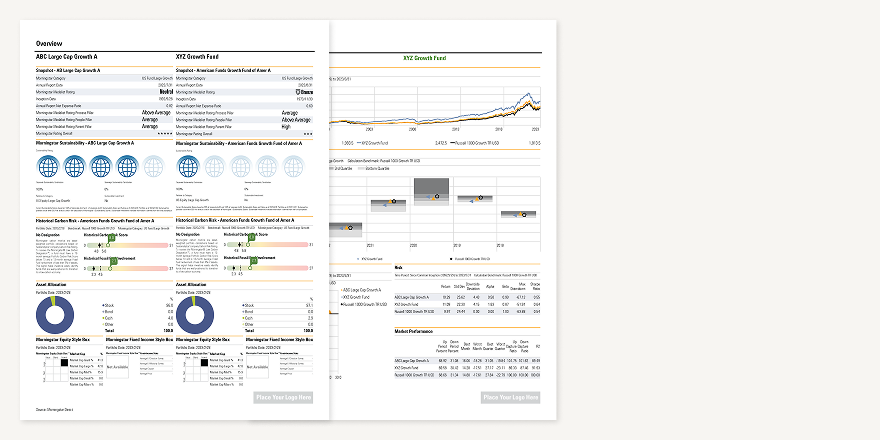
Morningstar Investment Comparison Report
The Most Popular Investment Reporting Templates
Understanding which reports investment teams use most frequently can provide valuable insights into industry trends and client needs. At Morningstar, we’ve analyzed data from our extensive database to identify the most popular reporting templates.
This analysis not only reflects current industry practices but also highlights the types of information that firms and their clients find most valuable. Let’s explore the top report types, their key features, and why they’ve become essential tools in the investment reporting landscape.

Our data is limited to the templates Morningstar provides within Morningstar Direct’s Presentation Studio. However, this feature contains over 70 different reporting templates, so this is still a comprehensive analysis of usage.
The data shows that our Equity Manager Analysis report is the most popular of the year, followed by the Holdings Comparison and Investment Detail Report to round out the top-3.
What does this mean for you?
Reporting templates give asset and wealth managers advantages including:
-
Compliance: Pre-approved templates can help you meet regulatory requirements, industry standards, and client needs.
-
Consistency: Batch, automate, and incorporate your own branding to create reports that are on time and on brand.
-
Customizability: Start with the foundations, then tailor the reports to your clients’ needs to create a personalized experience that clearly showcases your value.
-
“I want to differentiate my firm.” Use these popular reports as a foundation, then look for ways to enhance or customize them for your specific clientele.
Remember, templates can only do so much. It’s important you customize your reports to your clients’ needs while showcasing your firm’s unique value proposition. Personalization is the key to strong client relationships.
The advantage of investment reporting templates is that they provide a consistent framework for reporting to clients, making it easier to communicate complex financial information in a standardized format. This saves time and effort while also building trust with clients as it shows your professionalism and attention to detail.
When using templates, be mindful of customizing them to fit your specific brand standards and guidelines. This includes using your firm's logo, color scheme, and overall aesthetic into the reports. This will help differentiate your firm from others and reinforce your brand identity.
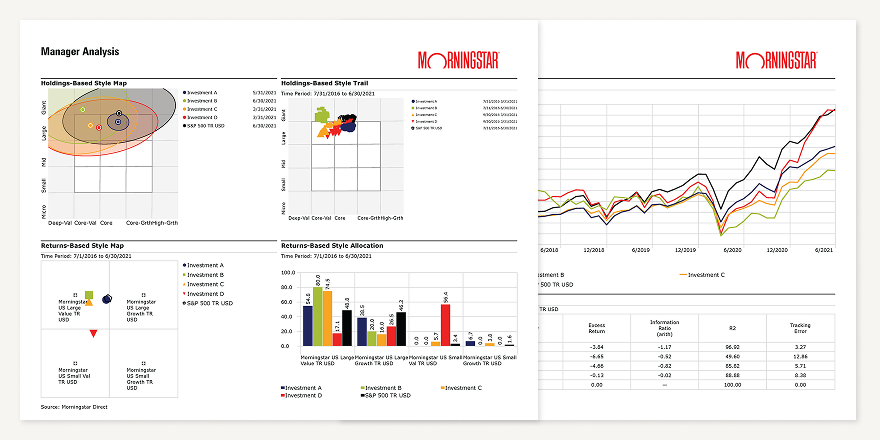
Morningstar Manager Analysis Report
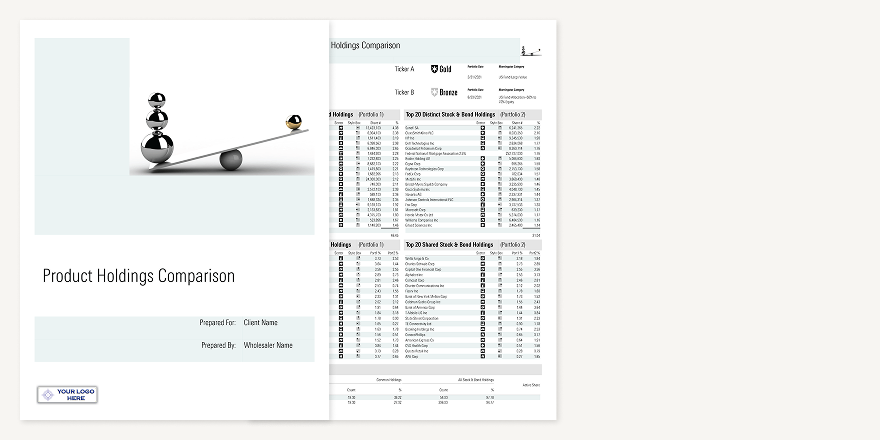
Morningstar Holdings Comparison Report
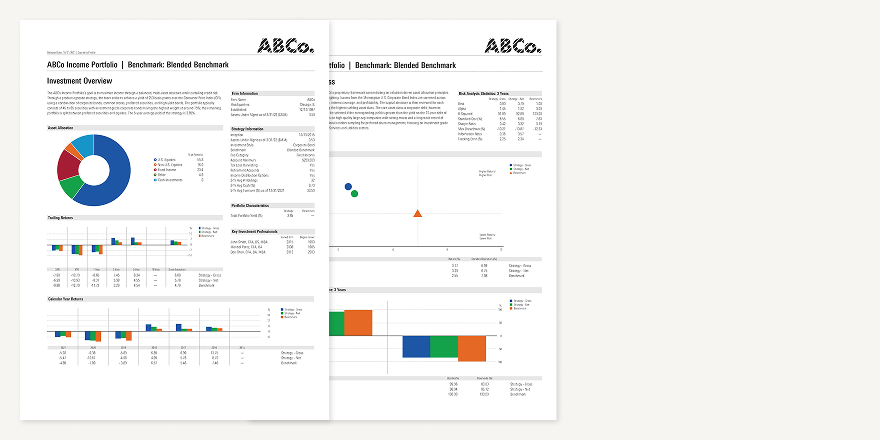
Morningstar Quarterly Profile Report
Overcoming Challenges with Investment Reporting Software and Solutions
Investment reporting software is a balancing act between efficiency and customization. On one end, off-the-shelf solutions offer speed and cost-effectiveness but lack tailored reporting options. On the other hand, highly customizable platforms provide flexibility at the cost of higher complexity and longer implementation times. Understanding this spectrum helps firms optimize their reporting processes.
1. High Efficiency, Low Customizability Solutions
These solutions emphasize speed and scalability through features like:
-
Pre-built templates
-
Automated data processing
-
Standardized methodologies
-
Quick deployment
Downside: Limited flexibility for unique client needs.
2. High Customizability, Low Efficiency Solutions
These platforms offer extensive customization with:
-
Bespoke report design
-
Flexible data input and calculations
-
Proprietary methodologies
Downside: Higher costs and longer setup times.
3. Balanced Solutions: Custom Reports at Scale
Modular systems, such as Morningstar’s suite, offer a balance with:
-
Standard and customizable components
-
Flexible data integration
-
Customizable and templated reports
When evaluating investment reporting software, firms should consider their client base, investment strategies, regulatory requirements, integration capabilities, scalability, and total cost of ownership. The right solution will depend on the specific needs and goals of each firm.
Morningstar’s Investment Reporting Solutions
Morningstar’s solutions are built for efficiency, compliance, and customization. Within Morningstar Direct you’ll find the Performance Reporting and Presentation Studio modules, which offer:
- Flexible report generation with both pre-built templates and custom options
- Comprehensive data integration
- Advanced analytics and customization capabilities
- Regulatory compliance features
- Interactive reporting options
With Morningstar Direct’s new browser experience, performance reporting has never been easier or more user-friendly. In the Performance Reporting module, you can access reports built on qualitative and quantitative factors to:
- Assign benchmarks
- Define data
- Performance ranking analysis
Monitor your investments through easy-to-read scorecards that use standardized values and custom grades to showcase top performers across categories and peer groups. The result? Automated due diligence processes that create on-brand, compliant, and actionable reports.
Our solutions are underpinned by Morningstar's comprehensive research and data. This means your reports are not only efficient and customizable, but also built on a solid foundation of accurate, in-depth information that spans global markets and asset classes.
With Morningstar's investment reporting solutions, asset and wealth management firms can produce high-quality, compliant reports that resonate with their audience, maximize efficiency in the reporting process, maintain their unique brand identity, and stay ahead of evolving regulatory requirements and market demands.